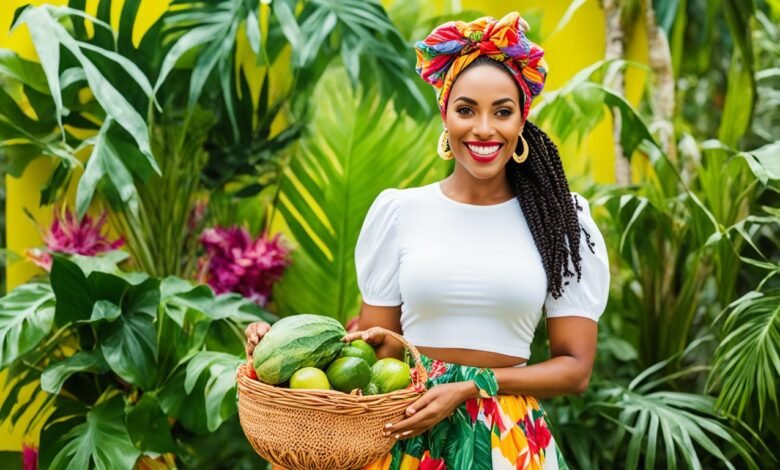Traditional Jamaican Clothing: Caribbean Fashion Guide

Traditional Jamaican clothing is a vibrant part of Caribbean fashion. It blends influences from indigenous peoples, colonial powers, and African heritage. This unique style reflects Jamaica’s rich cultural landscape.
Jamaican cultural attire is more than just fashion. It mirrors the island’s history, climate, and lifestyle. Each piece, from bandana patterns to tropical designs, tells a story.
Jamaican fashion has evolved over time. It mixes traditional elements with modern trends. Yet, it keeps its distinct identity, fascinating fashion lovers worldwide.
Let’s explore what makes traditional Jamaican clothing special in Caribbean fashion.
Key Takeaways
- Traditional Jamaican clothing reflects diverse cultural influences
- Vibrant colors and patterns are hallmarks of Jamaican fashion
- The bandana cloth is a symbol of Jamaican identity
- Jamaican attire adapts to the tropical climate
- Traditional clothing plays a role in cultural celebrations
- Jamaican fashion continues to evolve while preserving its roots
The Rich History of Jamaican Attire
Jamaican historical garments showcase a blend of cultural influences. The island’s fashion has evolved over centuries, mixing styles from various cultures. This colorful mix of clothing reflects Jamaica’s diverse heritage.
Indigenous Roots: Arawak and Taino Influences
Jamaica’s original inhabitants, the Arawak and Taino people, started the island’s clothing traditions. They used woven fabrics and decorative ornaments in their attire. This set the tone for Jamaica’s love of vibrant, expressive clothing.
Colonial Impact: Spanish and British Contributions
Spanish colonization brought European styles to Jamaica. The British influence in the late 17th century further shaped island fashion. These colonial powers introduced new fabrics and clothing styles to Jamaica.
African Heritage: Shaping Jamaican Fashion
African Jamaican clothing greatly influenced the island’s style. Slaves introduced head wraps, bright fabrics, and loose-fitting garments. These African influences significantly shaped Jamaican fashion, creating a unique blend.
The Maroon culture, born from escaped slaves, developed its own unique styles. Turbans and loincloths became symbols of their resistance and freedom. This added depth to Jamaica’s rich fashion story.
| Cultural Influence | Fashion Contribution | Significance |
|---|---|---|
| Arawak and Taino | Woven fabrics, decorative ornaments | Foundation of Jamaican style |
| Spanish and British | European styles, new fabrics | Colonial fashion influence |
| African | Head wraps, colorful fabrics, loose garments | Major shaper of Jamaican fashion |
| Maroon | Turbans, loincloths | Symbols of resistance and freedom |
Traditional Jamaican Clothing: A Colorful Tapestry
Jamaican folk costumes showcase the island’s rich cultural heritage. The vibrant mix of colors reflects diverse influences and tropical climate. Jamaican traditional clothing features fully-flared skirts made from bandana cloth for women.
These skirts are paired with fitted bodices and short puffy sleeves. White cotton petticoats trimmed with lace add elegance to the outfit.
Men’s Jamaican ethnic fashion focuses on practicality. They wear loose white pants and plain short-sleeved shirts. Wide-brimmed straw hats complete the look and provide sun protection.
Traditional Jamaican garments often use colors from the national flag. Red shows passion, yellow represents sunshine, and green reflects lush landscapes. Black signifies strength and cultural pride.
Natural fabrics like cotton, hemp, and linen are common in Jamaican fashion. These materials are perfect for the tropical climate. Accessories such as straw hats and cotton head-ties add style and serve practical purposes.
The Iconic Bandana Cloth: Symbol of Jamaican Identity
The bandana cloth is a key part of Jamaican national dress. Its red, white, and blue plaid pattern is a well-known Jamaican fashion symbol. The cloth’s story reflects Jamaica’s rich history.
Origins and Significance
The bandana cloth came from India’s Madras region. It arrived in Jamaica during colonial times and became a fashion staple. The cloth’s versatility made it ideal for Jamaica’s climate.
Today, people use it for skirts, blouses, and headwear. Its durability adds to its appeal in daily life.
Modern Adaptations of Bandana Patterns
Jamaican designers have updated the traditional bandana pattern. They’ve created modern styles while keeping its cultural value. The pattern now appears on chic dresses and stylish accessories.
- Bandana skirt and blouse: Iconic pieces of traditional Jamaican clothing
- Colors: Red, white, and blue plaid pattern symbolizing Jamaican identity
- Uses: Skirts, blouses, headwear, and modern fashion accessories
- Significance: Represents Jamaica’s cultural heritage and national pride
The bandana cloth’s popularity shows how tradition can stay relevant in modern fashion. It’s a vibrant symbol of Jamaica’s unique culture. The cloth blends global influences into a distinct Jamaican identity.
Women’s Traditional Attire: Elegance and Practicality
Jamaican women’s fashion blends grace and functionality beautifully. Traditional dresses showcase the island’s vibrant culture and rich history. The iconic quadrille dress features long, flowing skirts and ruffled blouses.
These ankle-length outfits reflect British-influenced modesty while adapting to Jamaica’s tropical climate. For special events, women wear elaborate versions, highlighting lively patterns and hues.

Traditional Jamaican attire’s popularity extends beyond the island. Keywords like “Jamaica color outfits” and “Jamaica-inspired fashion” trend globally. Hashtags such as #summeroutfit and #fashion often accompany Jamaica-related content.
Resort wear and vacation outfits draw inspiration from Jamaican aesthetics. “Jamaica Outfits Resort Wear” is gaining traction among tourists. The “Jamaican Crochet Dress” shows how traditional craftsmanship merges with modern fashion trends.
| Occasion | Popular Jamaican Attire | Key Features |
|---|---|---|
| Casual | Bandana skirt | Colorful patterns, lightweight fabric |
| Formal | Quadrille dress | Ruffled blouse, ankle-length skirt |
| Beach | Jamaica Summer Outfits | Breathable materials, vibrant prints |
| Cultural events | Jamaican Culture Day Outfit | Traditional elements, bold colors |
Jamaican women’s fashion influences bridal wear too. Bohemian-style dresses made from lightweight fabrics like chiffon or lace are popular. Vibrant bridesmaids’ dresses complement the island’s natural beauty, creating a stunning visual display.
Men’s Traditional Garments: Understated and Functional
Jamaican men’s fashion is simple and practical. It reflects the island’s tropical climate and rich cultural heritage. This style is evident in both everyday and formal attire.
Everyday Wear for Jamaican Men
Jamaican men’s daily wardrobe focuses on comfort and functionality. Loose-fitting white pants, often rolled up to the knees, are common. These are paired with plain, short-sleeved shirts made from breathable fabrics.
A leather belt or rope cinches the trousers at the waist. This adds a practical touch to the outfit.
Formal Attire for Special Occasions
For formal events, Jamaican men elevate their look while keeping traditional style. They add a black jacket or light coat to their basic attire. This creates a more polished appearance.
Headdresses are often worn at formal events. These serve both practical and cultural purposes.
| Occasion | Attire | Accessories |
|---|---|---|
| Everyday | White pants, short-sleeved shirt | Leather belt or rope |
| Formal | Black jacket or light coat | Headdress |
| Ceremonial | Traditional garments with cultural significance | Symbolic accessories |
Jamaican men’s fashion blends cultural influences and practical needs. Contemporary styles adapt while preserving traditional understated elegance. Modern elements are incorporated, keeping the essence of Jamaican menswear alive.
The Role of Climate in Shaping Jamaican Fashion
Jamaica’s tropical climate shapes its fashion landscape. The Caribbean weather affects fabric choices and designs. Lightweight materials like cotton and burlap are popular for breathability.
Jamaican fashion features loose-fitting garments for air circulation and sun protection. This approach blends functionality with style. Vibrant colors and patterns reflect the island’s lively culture.
Climate influences both traditional and modern Jamaican designs. Designers draw inspiration from the tropical environment. They create garments suitable for various occasions while maintaining Caribbean style.
| Climate Factor | Fashion Adaptation |
|---|---|
| High temperatures | Loose-fitting garments |
| Humidity | Breathable fabrics |
| Strong sunlight | Sun-protective designs |
| Tropical rains | Quick-drying materials |
Jamaican fashion reflects the island’s multicultural heritage. A 2003 study explored Jamaican women’s clothing from 1838 to 1962. It revealed a blend of European, African, Indian, and Chinese elements.
This fusion embodies Jamaica’s motto, “Out of Many, One People.” It continues to influence modern Jamaican fashion trends.
Cultural Influences on Jamaican Clothing Styles
Jamaican fashion reflects a rich tapestry of cultural influences. The island’s diverse heritage shapes clothing styles from Kingston to Montego Bay. These styles also showcase Jamaica’s dynamic music scene.
Rastafarian Impact on Fashion
Rastafarian garments have left a lasting mark on Jamaican fashion. This spiritual movement introduced distinctive elements to the island’s style in the 1930s.
Rastafarians often wear loose-fitting clothing in red, gold, and green. These colors symbolize their beliefs. Long dreadlocks, a Rastafarian hallmark, have become popular beyond the movement.
Music and its Influence on Jamaican Attire
Reggae fashion has greatly shaped Jamaican clothing trends. Icons like Bob Marley popularized knitted hats and bell-bottom pants.
The 1980s saw the rise of dancehall style. It featured bold, provocative outfits. Flashy jewelry and colorful hairstyles became staples of this genre-inspired fashion.
| Music Genre | Fashion Elements | Notable Features |
|---|---|---|
| Reggae | Knitted hats, bell-bottom pants | Comfortable, laid-back style |
| Dancehall | Flashy jewelry, bold outfits | Provocative, attention-grabbing looks |
| Ska | Slim-fit suits, pork pie hats | Sharp, sophisticated appearance |
These cultural influences continue to shape modern Jamaican fashion. Designers mix traditional elements with current trends. They create unique styles that honor Jamaica’s heritage and embrace global fashion.
Evolution of Traditional Jamaican Headwear
Jamaican head ties and headdresses are vital to the island’s fashion history. These vibrant accessories blend African, European, and indigenous influences. They showcase Jamaica’s rich cultural heritage in a unique way.
Women’s headwear often features intricately wrapped scarves. These serve practical purposes and add flair to outfits. The art of tying these scarves has been passed down through generations.

Men’s hat styles typically include wide-brimmed straw hats. These are crafted from dried Silver Palm leaves for sun protection. They highlight local craftsmanship and inspire modern fashion trends.
The Rastafarian movement has greatly influenced Jamaican headwear. The iconic “tam” hat covers dreadlocks and represents Jamaican style. These hats often use red, green, and gold, reflecting the movement’s cultural connections.
| Headwear Type | Material | Cultural Significance |
|---|---|---|
| Women’s Head Ties | Calico Fabric | African Heritage |
| Men’s Straw Hats | Silver Palm Leaves | Practical Sun Protection |
| Rastafarian Tam | Natural Fibers | Spiritual Expression |
Footwear in Jamaican Culture: From Wompers to Modern Styles
Jamaican footwear showcases the island’s resourcefulness and creativity. It started with “wompers,” simple shoes made from leaves and grass. These early designs highlighted Jamaicans’ ingenuity in using natural materials.
Caribbean footwear evolved with the island’s changing landscape. Jamaicans used new materials that washed ashore to adapt their shoe designs. This blend of necessity and innovation became a hallmark of Jamaican fashion.
Modern Jamaican shoe styles have diversified, embracing global trends and traditional roots. They combine comfort, practicality, and style, reflecting the island’s dynamic fashion sense. Options range from casual beach sandals to sleek dress shoes for formal events.
The journey of Jamaican shoes mirrors the island’s fashion evolution. It shows Jamaica’s ability to adapt and create unique styles. These designs resonate both locally and internationally in Caribbean fashion.
FAQ
What are the origins of traditional Jamaican clothing?
Traditional Jamaican clothing stems from various cultural influences. These include indigenous Arawak and Taino cultures, Spanish and British colonization, and African heritage. Enslaved peoples brought their traditions, shaping Jamaica’s unique style.
What are some key features of traditional Jamaican attire?
Jamaican clothing bursts with vibrant colors and intricate patterns. Loose-fitting designs suit the tropical climate perfectly. Bandana cloth, head wraps, and lightweight cotton fabrics are common elements.
What is the significance of the bandana cloth in Jamaican fashion?
The red, white, and blue plaid bandana cloth symbolizes Jamaican identity. It originated in India but became iconic in Jamaica. Traditional garments like skirts and blouses often feature this cloth.
Modern designs continue to reimagine the bandana pattern in new ways.
How has the Jamaican climate influenced traditional clothing?
Jamaica’s tropical climate greatly shapes its fashion choices. Lightweight, breathable fabrics are essential for comfort. Loose-fitting styles allow air circulation while protecting from the sun.
What are some cultural influences on Jamaican clothing styles?
The Rastafarian movement introduced dreadlocks and red, gold, and green colors. Music genres like reggae and dancehall have also shaped fashion trends. These influences create a unique Jamaican style.
What is the significance of headwear in Jamaican traditional clothing?
Headwear holds great importance in Jamaican culture. Women’s head ties reflect African heritage and marital status. Men often wear wide-brimmed straw hats made from Silver Palm leaves.
How has traditional Jamaican footwear evolved over time?
Early Jamaican shoes, called “wompers,” were made from grass and leaves. Later, they incorporated materials that washed ashore. Today’s footwear blends comfort and style with traditional inspirations.





